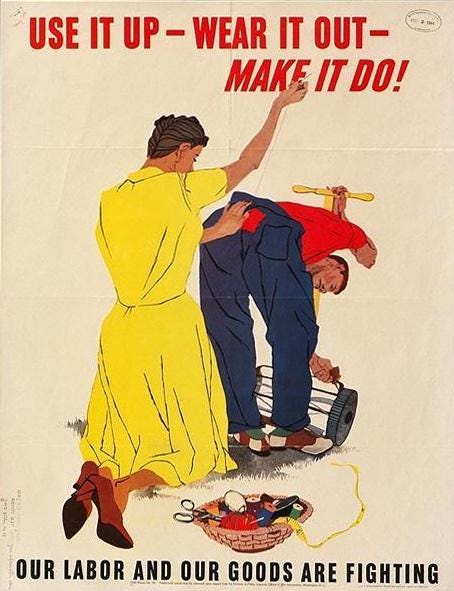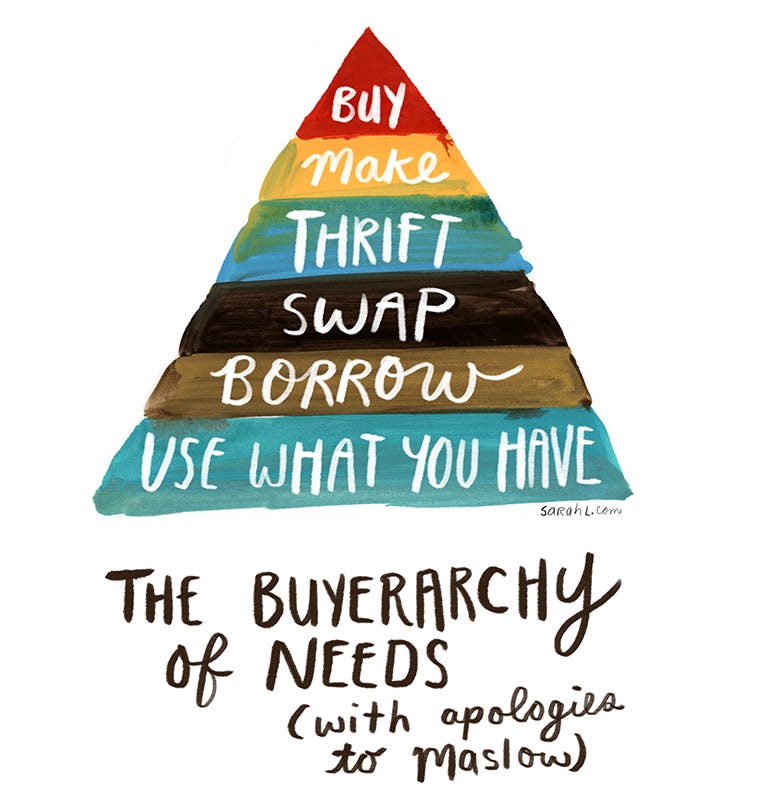
Pop quiz!
How many new fashion items do you think the average Canadian buys each year?
a. 22
b. 48
c. 70
Really, guess. I’ll wait.
The answer, I’m sorry to say, is c. Around the world, people consume 80 billion new clothing items a year. We’re buying 60% more clothing than in 2000 and keeping items half as long. Plus, 60% of that clothing is made from oil. All of this amounts to an extraordinary amount of clothing spun from oil and shipped all over just to head to landfill for hundreds of years (more on getting rid of clothing in another newsletter), a pit of consumer debt, and many a day spent piling all of your t-shirts in the middle of your bed as you inspect them for joy sparkage.
Fashionopolis author Dana Thomas calls this binge and purge cycle “fashion bulimia,” and the planet is the one getting sick. Fashion accounts for 10% of world carbon emissions, as much as the aviation and maritime shipping industries combined. It’s also the world’s second largest water consumer and the second largest polluter of water thanks to textile dye runoff. (We’ll save the microplastics they release when washed for future fun! I’ve also set aside the human rights abuses associated with factory conditions — a whole other important topic — but many factories are still exploiting women and children the world over. If you consider yourself a feminist, ask yourself if your feminism applies to factory workers.)
And our fashion binging is only getting worse. If current trends continue as the middle class grows, by 2050 we’ll need three times the resources to meet the demand stoked by Zara, H&M, and their ilk who decided, Why have two fashion seasons a year when you can have fifty?
Luckily, this is another one of those areas where individual choices can make a huge difference. Every time you don’t buy something new, you keep resources in the ground, thereby avoiding releasing carbon, polluting rivers and air, abusing fellow humans, and adding to our methane-belching landfills. All wins!
Consumers may not have created this firestorm of fast fashion, but we can stamp out the flames. Of course, this will be easier for some people than others: your location, your body’s shape and ability, and your budget are all factors, but at least a few of these tactics should be available to everyone.
Calculate your fashion footprint.
ThredUp has a nifty online tool: in just a couple minutes, you can get some sense of how your fashion consumption is affecting the planet.
Unsubscribe from promotional newsletters.
As a lifelong bargain junkie, this was a tough one for me. I didn’t want to miss a great deal! You can always resubscribe if you miss three emails a week from your pen pal the Gap, but you might find it peaceful. Plus, you won’t miss a product you never knew existed. This applies to Instagram, Pinterest, etc., too — if someone makes you want to buy things, consider unfollowing.
Stay out of the mall.
For similar reasons as above. We’ve been told that shopping is fun, but is it really fun to spend hours looking at things you won’t have? Comparing your body to mannequins, your living room to the EQ3 showroom? Then spending the money earned from hours of toiling away? Personally, I hate that shopping sends my brain into a kind of frantic overstimulation and drains my precious stores of personal control. If you stay out of a mall long enough, your return to one will be such a sensory overload it’ll make you feel like you’re on mushrooms at the Moulin Rouge.
Wait 48 hours before you buy.
You’d be amazed how well this works. Sometimes despite our best intentions, we find we’ve got those new shoes in the online cart, plus, of course, a shirt you feel meh about to get that free shipping. Press pause for 24 to 48 hours and see if it still qualifies as a must-have (and remember 90% of online returns are headed to landfill!). Usually your buying fever will have broken in a day or two.
Borrow what you need.
Though the impossibility of wearing the same outfit to multiple weddings seems to me like some holdover from Austen-era balls when it was also common to wear an entire stuffed bird on your hat, it is a thing for a lot of people, particularly women. But most of us have formalwear hanging in our closets, so if you have similar-sized friends, ask if they have something they might loan you for your next bit of high-heeled hoopla. You can also rent an outfit from places like The Fitzroy or Boro. The same philosophy applies to infrequent events like a job interview or, recently for me, a trip to a Muslim country where I needed some warm-weather modesty wear.
Shop secondhand.
You have to be in the mood, but sometimes you can find some really epic bargains. My friend J just discovered the chain Talize, which has better prices, selection, and organization than Value Village (things sorted by size and colour!). Certain boutiques will also buy your clothes back from you, earning you cash or store credit, but you must bring clothes for the current buying season and be willing to risk the barely masked condescension of a hipster in mismatched animal print.
You can also buy secondhand online. American secondhand online retailer ThredUp is now available in Canada, though customs fees will apply. Facebook Marketplace or local bartering groups are also full of great deals. My pal K is a FB Marketplace ace and has made a couple grand (!) selling the stuff her son has grown out of while scoring some great secondhand deals.
Host a clothing swap.
The last two Aprils, I’ve hosted a clothing swap for a group of 10 or so people and it has given me 90% of my new clothes for the year. My swap has no rules except that people can bring a maximum of 12 clean items in good condition. (This helps people bring their best stuff and prevents me from being trapped in a landslide of promotional t-shirts. Note to all business owners: ENOUGH WITH THE T-SHIRTS. NOBODY CARES.) Other swaps have more rules, but in a small group, I’ve found common decency has always been enough to keep things turning into the stuff of reality TV. You can also skip hosting and simply attend a swap (Facebook listings are good places to find them), but hosting is a chance to affect not only your habits but other people’s. Plus, I swear you’ll get better stuff. I serve mimosas and snacks, and we all have a really nice time.
Try a buying ban.
For all-or-nothing types, this can be great. Hard-and-fast rules can provide a fantastic freedom from decision-making. You don’t have to do a whole year, but I’d recommend at least three months. In 2018, I bought no new clothes, shoes, or accessories. In 2019, you might think I went on a bender, but only eight new items made their way into my wardrobe all year (and three of those were pairs of socks).
Repair before you replace.
Thanks to the demise of home ec and the rise of fast fashion, most of us aren’t great with a needle and thread, but luckily home ec can come to you with YouTube tutorials galore. Trends like visible mending mean you don’t even need mad skills to patch something up. If you’d rather poke a needle in your eye than through a garment, you can take your item to tailor, cobbler or, if your city has them, a repair café, in which a volunteer mender will be the elf to your shoemaker. You’ll save money, keep an item out of landfill, and get to keep wearing the thing you’ve (literally) loved to pieces.

I love a vintage WWII poster, and they often have mottos I find useful 75 years later. That said, I’d recommend mending pants without a man in them.
When you buy new, buy quality.
If you’re going to vote with your dollar, as they say, what are you voting for? Local makers and businesses? Sustainable production? Quality workmanship? A closed loop system? Of course these attributes can double, triple, even quadruple an item’s price tag, so this isn’t always a possibility, and you can decide what better means to you. I use the free app Good on You to get some insight into the labour and environment practices of the place I’m considering supporting. They don’t rate all brands, but it’s a start and easier than trying to see through the greenwashing of a brand’s info page.
One caveat: according to this recent article in Behavioral Scientist, buying from a green brand doesn’t necessarily correlate with more happiness, but buying less stuff does. Buying can give us a quick fix of pleasure, but we’re really just puffing away on the hedonic treadmill.
For the busiest people, TL;DR
We’re buying more clothes than ever, and the planet is paying the price: 10% of emissions worldwide come from the fashion industry. Use this tool to measure your personal fashion footprint.
To help resist the fast fashion frenzy, unsubscribe from shopping newsletters, implement a waiting period when online shopping, stay away out of the mall, and consider a buying ban.
Avoid buying new clothes whenever possible: try borrowing, swapping, renting, repairing, or buying secondhand to help keep old clothes out of landfill and new ones from being made.
When you buy something new, buy quality whenever possible.
Learn more to level up
Read
I loved this Globe and Mail opinion piece by Benjamin Lsezcz, “The life-changing magic of making do.” (I felt a flash of fondness for ol’ Prince Charles.)
Writer Ann Patchett’s wonderful New York Times piece on her shopping-free year.
Sarah Lazarovic’s graphic memoir A Bunch of Pretty Things I Did Not Buy is so nice I’ve read it twice. Lazarovic isn’t preachy and is sensitive to nuance, which, coupled with her delightful illustrations, makes a tough topic pleasant. It contains Lazarovic’s now-famous (in eco circles at least) Buyerarchy of Needs, which is my modus operandi for acquiring new things.

Watch
For a quick and often funny breakdown of our fast fashion predicament, check out the Patriot Act with Hasan Minhaj episode “The Ugly Truth of Fast Fashion” (30 min).
For a more thorough deprogramming, check out documentary The True Cost (92 min).
Now tell me
Hit reply with the ways you’ve lowered your fashion footprint, share your favourite vintage stores or green(er) brands, etc.! I love hearing from y’all.



